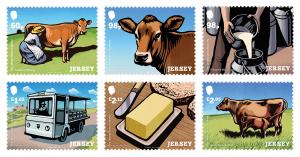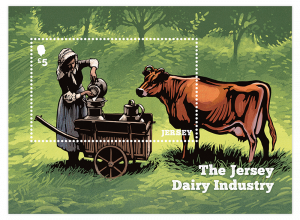
Jersey is known worldwide for producing rich dairy products such as ice cream, butter and of course milk from the Island’s beloved cows. Issued on Thursday 24th October 2024 The Jersey Dairy Industry stamps celebrate the work of Jersey farmers and the Royal Jersey Agricultural & Horticultural Society, with illustrations depicting the products and processes of the dairy industry in Jersey.
The original artwork is designed by British illustrator, Chris Wormell, who created the first two issue of the series; 150 Years of Brewing in Jersey in 2021, and A History of Knitting in Jersey in 2023.
The 60p stamp illustrates the process of traditional hand milking. On average, Jersey milk contains 40% more fat, 18% more protein, 20% more calcium and a higher concentration of minerals and vitamins than milk from other breeds of cows.
A portrait of a Jersey cow has been illustrated for the first 98p stamp. Interestingly, in 1789 the States of Jersey introduced the first legislation to protect the purity of the breed by banning the import of cattle into the Island. That ban still exists and every drop of milk supplied to Jersey Dairy continues to be produced exclusively by pre-breed Jersey who can trace the purity of their lineage.
The second 98p stamp features a milk churn, which was previously used to store milk. Despite the name, milk churns weren’t used to churn milk. In 1974, due to the increase of the Island’s population, the decision was made by the Jersey Dairy to move on to milk tankers to collect a larger supply of milk from Jersey’s farms.
Illustrated on route past Mont Orgueil Castle in Gorey, the £1.65 stamp illustrates a milk float. These vehicles used to be used to transport fresh milk, which would be delivered to the locals doorsteps. Milk floats weren’t particularly large vehicles, making them idea for navigating the narrow and winding roads of Jersey.
Chris Wormell has used distinct colours to highlight the block of butter illustrated in the £2.15 stamp. Butter is the second oldest dairy product, after milk, that the industry has produced. Jersey butter has a distinct yellow colour and can be used for cooking, baking and general use.
For the sixth stamp in the issue a cow and her calf have been illustrated. Jersey cows are a smaller breed of cow and are often viewed as a docile and undemanding breed. The cows are tolerant of high temperatures and produce a large quantity of milk in relation to their size and demand for food.
The miniature sheet features a milkmaid, wearing a sun bonnet, a headdress developed in the 19th and early 20th centuries to ensure protection from the sun when out doing tasks in the field. The Jersey sun bonnet was built over a structure of canes which supported its shape and was then tied with a ribbon under the chin.
The Jersey Dairy Industry has undergone various changes throughout the years, but something that has remained strong within the industry is the importance of preserving Jersey cows. The bovine is a beloved part of the Jersey’s heritage and continue to produce rich milk for islanders.

 Åland
Åland  Faroe Islands
Faroe Islands  Gibraltar
Gibraltar  Greenland
Greenland  Guernsey
Guernsey  Isle of Man
Isle of Man  Jersey
Jersey  Liechtenstein
Liechtenstein  Luxembourg
Luxembourg  Malta
Malta  Monaco
Monaco  Vatican City
Vatican City 
